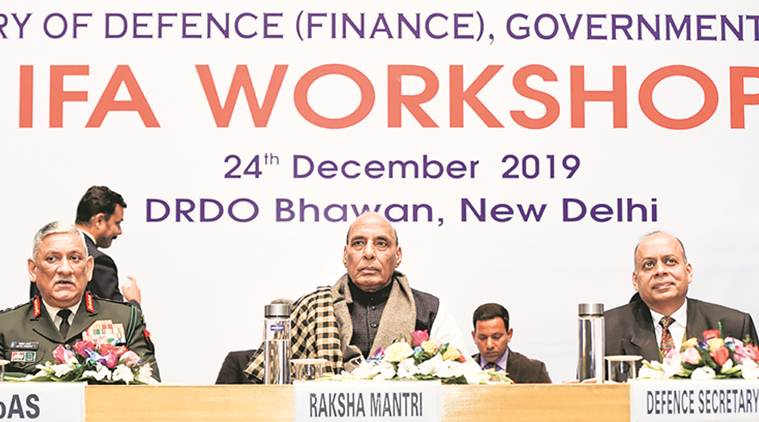The CDS will not exercise any military command, including over the three services chiefs, so as to be able to provide impartial advice to the political leadership.

Army Chief Gen Bipin Rawat, Defence Minister Rajnath Singh, Defence Secretary Ajay Kumar in New Delhi, Tuesday. (Photo: PTI)
The Union Cabinet Tuesday approved creation of the post of Chief of Defence Staff (CDS) as principal military advisor to the government. In line with the landmark announcement made by Prime Minister Narendra Modi in his Independence Day speech, this fulfils a long-standing recommendation for higher military reform, recommended by various expert committees and group of ministers, more so after the 1999 Kargil War.
The CDS will not exercise any military command, including over the three services chiefs, so as to be able to provide impartial advice to the political leadership.
The CDS will be a four-star General, at par in military rank, salary and perquisites with the three services chiefs, and will head the newly created Department of Military Affairs in the Ministry of Defence and function as its Secretary.
Making the announcement, Union Minister Prakash Javadekar said, “CDS will have all powers of a Secretary-level officer. The files need not go through the Defence Secretary and the CDS will be empowered to send to it directly to the Defence Minister.”
Apart from being the head of the Department of Military Affairs, the CDS will also be the Permanent Chairman of the Chiefs of Staff Committee. He will act as the Principal Military Adviser to the Defence Minister on all tri-services matters. In a clear delineation of roles, the three services chiefs will continue to advise the Minister on matters exclusively concerning their respective services.
The Department of Military Affairs, headed by the CDS, will deal with the armed forces — the Army, Navy and Air Force; works relating to the Army, Navy and Air Force; and procurement exclusive to the services except capital acquisitions. His mandate will also include promoting jointness in procurement, training and staffing for the defence services through joint planning and integration of their requirements; facilitation of restructuring of military commands for optimal utilisation of resources by bringing about jointness in operations, including through establishment of joint/theatre commands; and promoting use of indigenous equipment by the services.
The CDS will administer all the tri-services organisations in the ministry, including those related to cyber and space. He will be member of the Defence Acquisition Council and Defence Planning Committee, besides functioning as the Military Adviser to the Nuclear Command Authority. His task will be to implement Five-Year Defence Capital Acquisition Plan (DCAP), and two-year roll-on Annual Acquisition Plans (AAP), as a follow up of Integrated Capability Development Plan (ICDP), besides assigning inter-services prioritisation to capital acquisition proposal.
The CDS will also bring about reforms in the functioning of three services aimed at augmenting combat capabilities of the Armed Forces by reducing wasteful expenditure, while ensuring optimal utilisation of infrastructure and rationalising it through jointness among the services. He has been given a period of three years to bring about jointness in operation, logistics, transport, training, support services, communications, repairs and maintenance, etc of the three services.
This approval follows the announcement made by the Prime Minister from the ramparts of the Red Fort on August 15: “India should not have a fragmented approach. Our entire military power will have to work in unison and move forward. All the three (services) should move simultaneously at the same pace. There should be good coordination and it should be relevant to the hope and aspirations of our people. It should be in line with the changing war and security environment with the world.after formation of this post (CDS), all the three forces will get effective leadership at the top level.”








































































